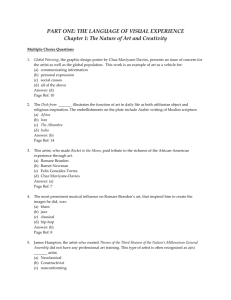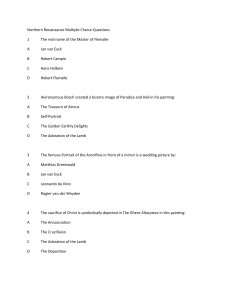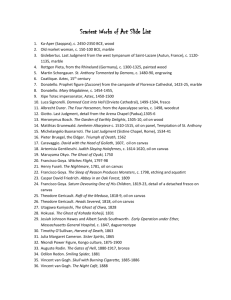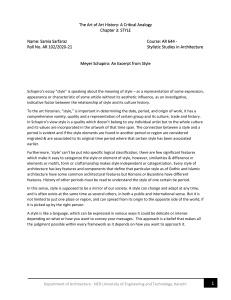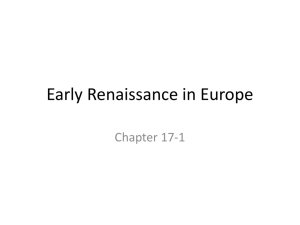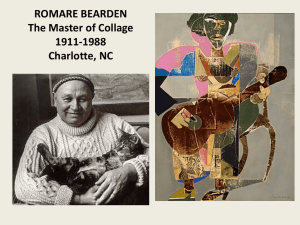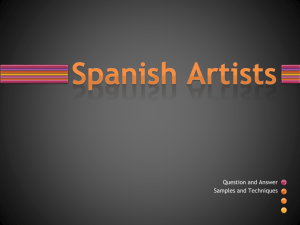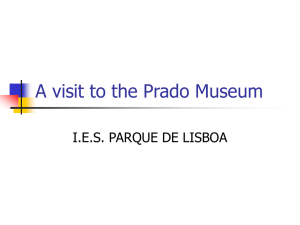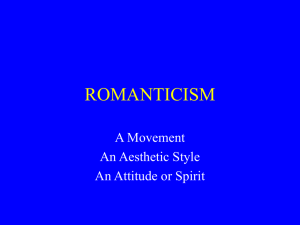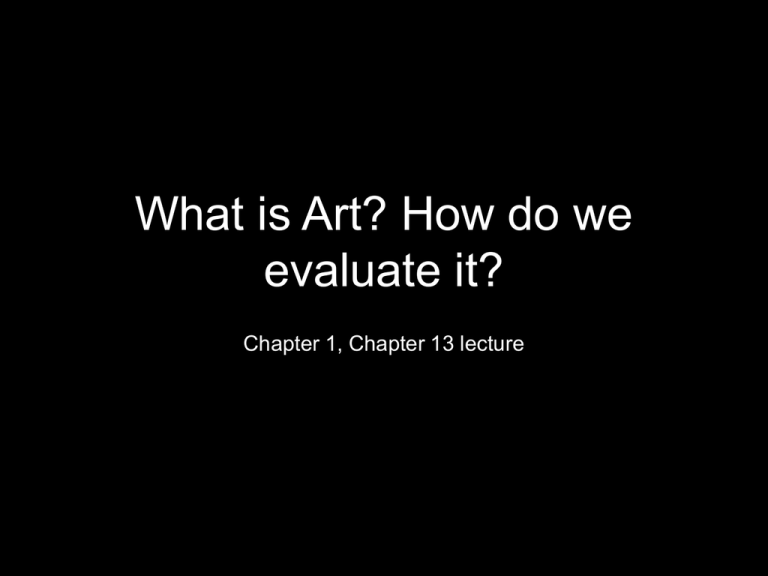
What is Art? How do we
evaluate it?
Chapter 1, Chapter 13 lecture
What is art?
• Concise Oxford English Dictionary: “The
expression or application of creative skill and
imagination, especially through a visual medium
such as painting or sculpture”
• Merriam Webster Dictionary: “The conscious use
of skill and creative imagination especially in the
production of aesthetic objects; also works so
produced”
What do other people think?
• “Art amplifies itself to something universal”
– Romare Bearden
• “The job of the artist is always to deepen the mystery.”
– Francis Bacon
• “The holy grail is to spend less time making a picture
than it takes people to look at it.” – Banksy
• “Art is made to disturb. Science reassures. There is only
one valuable thing in art: the thing you cannot explain.”
– Georges Braque
Terms to Know
• Work of art – what an artist makes or puts in front of us
for viewing, the visual object (or product) that embodies
that idea the artist wanted to communicate.
• Medium (plural media) – a particular material along
with its accompanying technique, a specific type of
artistic technique or means of expression determined by
the use of particular materials
– Clay, fiber, stone, wood, paint, video, computer/digital, photograph,
movie
• Oil on canvas, silver gelatin print, etc
Functions of Art
Communicating Information
Jan Van Eyck, Ghent Altarpiece, 1430-32
Day to Day Living
Yves Behar. Mission One. 2009
Claes Oldenburg, Spoonbridge and
Cherry, 1985-1988, aluminum,
stainless steel, paint
Worship and Ritual
Dance Wand in Honor of Eshu.
Jan Van Eyck, Ghent Altarpiece, 1430-32
Elegba Cult. Yoruba, Nigeria.
Copyright ©2011, ©2009 Pearson Prentice Hall Inc.
Self Expression
Rembrandt van Rijn. Self-Portrait. 1658
Yong Soon Min. Dwelling. 1994
Self Expression continued
Romare Bearden. Rocket to the Moon. 1971.
Copyright ©2011, ©2009 Pearson Prentice Hall Inc.
Social Cause
Francisco Goya. The Disasters of War,
No. 18: Bury Them and Say Nothing. 1818.
Etchings
Francisco Goya. The Third of May, 1808.
1814. Oil on Canvas.
Social Cause continued
Félix González-Torres. Untitled (Death by
Gun). Installation view. 1990.
Félix González-Torres. Untitled (Portrait
of Ross in LA). Installation view. 1991.
Visual Delight
Miriam Schapiro. Heartland. 1985.
Visual Delight: Is that too simplistic?
Miriam Schapiro. Heartland. 1985.
Francisco Goya. The Third of May, 1808.
1814. Oil on Canvas.
What is Creativity?
• Insightful seeing
• Being receptive to new things
• Putting aside preconceived notions of art
Evaluating Art
Art Criticism : Three Basic Theories
• Formal, aka formalism – focus attention on the
composition of the work and how it may have been
influenced, on a compositional level, by earlier works,
analyses these qualities over (or with no respect to) other
aspects of a work’s production, reception, subject matter,
or thematic significance.
• Contextual – considers art as a product of a cultural that
exists within a cultural and value system, within a
particular society as a particular time and place
• Expressive, aka biographical – pays attention to the
artists’s expression of a personality or worldview, takes
into account birthplace, gender, cultural background, etc.
What makes art great?
• Some degree of innovation
• Important cultural meaning
• Recognizable personal statement
How should you act in a museum?
Frank Modell.
Homework
Write a paragraph (at least four sentences
each) for each of these questions and
then pick a piece from your book that
exhibits the characteristics that you
explain. Give me the artist, title of the
work, and page number it appears on in
your book.
1) What are your characteristics for a “good” work
of art, a masterpiece?
2) What attracts you to a work of art?

